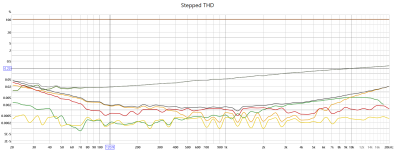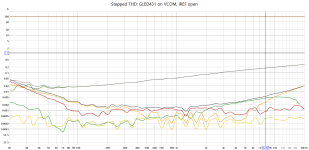I know, I know, the PCM1794A, PCM1798 and similar are wildly unfashionable at this point. That said, they're not terribly expensive, and are relatively easy to implement using hardware control. I'd like to see how much performance we can milk out of them.
Paul Frost over at the TI E2E forum shared a schematic approximating what the IREF and VCOM pins actually do. (Over here.) Here's the schematic; note that VREF1 and VCOM2 pins are not physically accessible on the chip

I've seen many projects where the IREF pin is fed by a CCS. It looks like this would more or less take the servo amp out of the equation; the CCS sets the current though the current mirror which biases the LTP CCSs which make up the output stage. This also aligns well with the projects I've read here: reducing R_IREF increases the ouput current and changes the voltage on the VCOM pin.
That said, I haven't seen any experiments where the VCOM pin is fed by an external voltage reference. I tried connecting a GLED431 reference from VCOM to VCC with a 4mA CCS from VCOM to ground. This also scales the output current, but the DAC seems to work well. There's nothing obviously wrong with the sound and measurements are comparable with to using a CCS on IREF and a large cap on VCOM (but not directly comparable as I haven't matched the levels at 0dBFS).
Would anyone have thoughts on the technical merits of either approach? I would assume that we could provide a higher quality offboard reference, but I think I'm missing some of the subtlety of the servo amp. What exactly is it servo-ing?
Paul Frost over at the TI E2E forum shared a schematic approximating what the IREF and VCOM pins actually do. (Over here.) Here's the schematic; note that VREF1 and VCOM2 pins are not physically accessible on the chip
I've seen many projects where the IREF pin is fed by a CCS. It looks like this would more or less take the servo amp out of the equation; the CCS sets the current though the current mirror which biases the LTP CCSs which make up the output stage. This also aligns well with the projects I've read here: reducing R_IREF increases the ouput current and changes the voltage on the VCOM pin.
That said, I haven't seen any experiments where the VCOM pin is fed by an external voltage reference. I tried connecting a GLED431 reference from VCOM to VCC with a 4mA CCS from VCOM to ground. This also scales the output current, but the DAC seems to work well. There's nothing obviously wrong with the sound and measurements are comparable with to using a CCS on IREF and a large cap on VCOM (but not directly comparable as I haven't matched the levels at 0dBFS).
Would anyone have thoughts on the technical merits of either approach? I would assume that we could provide a higher quality offboard reference, but I think I'm missing some of the subtlety of the servo amp. What exactly is it servo-ing?
Well, I tried it.
I tried to replicate @bohrok2610's measurement methodology from the DS phase noise thread. My measurements look pretty awful by comparison, so please take with a good dose of salt. The red trace is a fairly standard CCS on IREF implementation with 100u from VCOM to VCC. Blue is with a GLED431 in lieu of the cap, and the IREF pin left open. The CCS current was adjusted with a trimpot such that the voltage from VCOM to VCC was constant between the two tests.

THD is also really quite close. There is a modest reduction in noise below 100Hz. The rise in THD below 100Hz is likely from the I/V stage, which is transformer-coupled.


I'll investigate further.
I tried to replicate @bohrok2610's measurement methodology from the DS phase noise thread. My measurements look pretty awful by comparison, so please take with a good dose of salt. The red trace is a fairly standard CCS on IREF implementation with 100u from VCOM to VCC. Blue is with a GLED431 in lieu of the cap, and the IREF pin left open. The CCS current was adjusted with a trimpot such that the voltage from VCOM to VCC was constant between the two tests.
THD is also really quite close. There is a modest reduction in noise below 100Hz. The rise in THD below 100Hz is likely from the I/V stage, which is transformer-coupled.
I'll investigate further.

